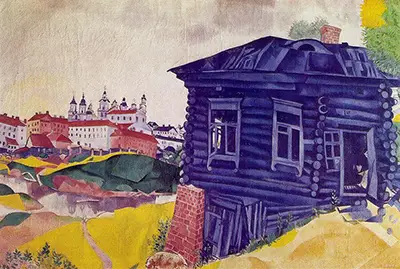A wall of red bricks supports one side of the blue wooden house as it is built on a steep environment. On that same side, several logs support the house next to the red brick wall. The front door is open, and the inside part is very dark, but there is light emanating from the window on the other side. There is a small path leading down to the river just next to the house. On each side of the pathway is a sloping meadowland. In the background, high up on the other side of the river stands some beautifully made and maintained middle-class stone houses reflected in the river. It seems to be a city or a town. The two contrasting setups show the big difference in the landscapes and environment for the two sides of the river.
The painting also brings a feeling of abandonment and a unique perception of the world in the viewer's mind. The creation brings about two contrasting parts, and the colours used are full of emotion. There is a form of symbolism that the river brings out, as it separates the two sides. Life seems to be good in the town with development, but the other side looks abandoned and impoverished. Also, there is a sense of hopelessness that comes out of the abandoned blue house while the city is full of hope and life. The painting brings out two sides of life clearly, and the landscape with the river separating them shows the big difference between life in the two sides of the river. The centre of focus is the blue house, isolated all alone on one side of the river.
The viewers' attention is captured as they try to figure out why the blue house is all alone on one side and made from wood while the others are built from stone. The painting also creates suspense as the viewer wonders if somebody lives in the abandoned blue house. The artwork is highly valued and is currently located in the Liège Museum of Fine Arts (BAL), Liège, Belgium.
